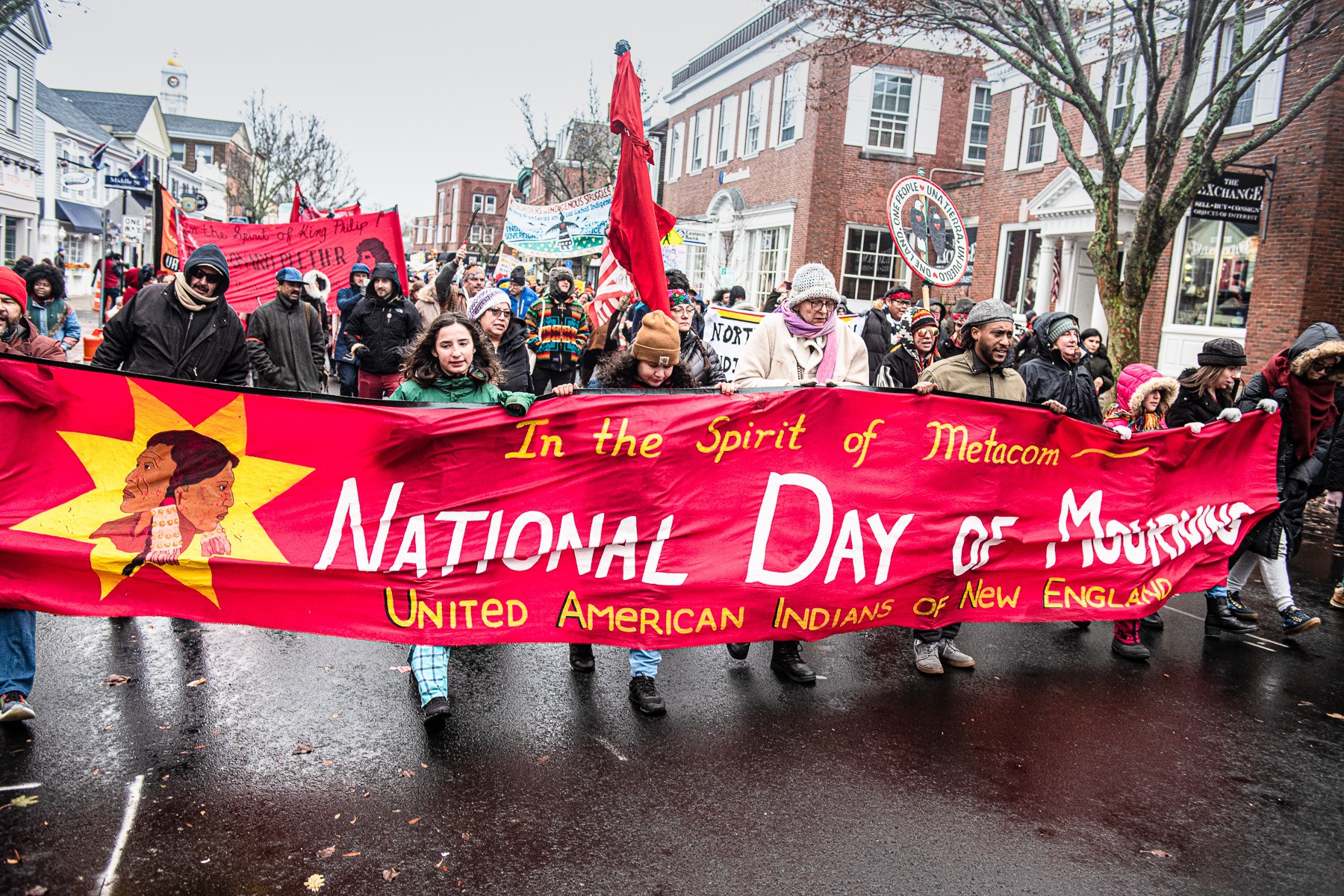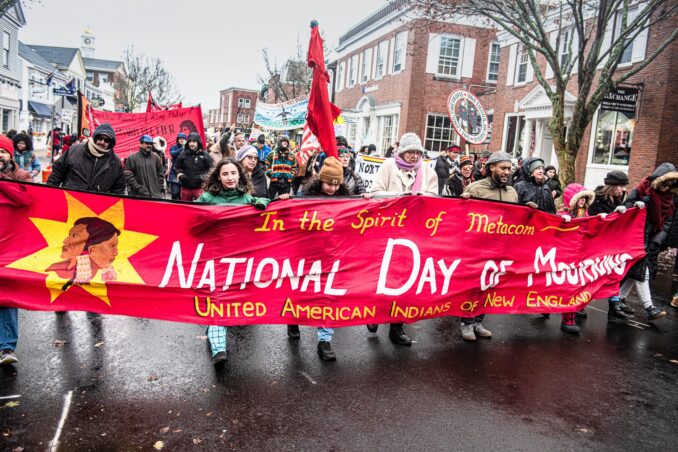

Plymouth, Massachusetts, November 2019 (WW Photo: Rachel Jones)
What are the United States’ foundational myths? Who created them, and who do they erase and harm? For the past 52 years, United American Indians of New England (UAINE) and supporters have gathered on so-called Thanksgiving Day in Plymouth, Massachusetts, to ask these questions, confront settler mythologies and commemorate a National Day of Mourning for the Indigenous people murdered by settler colonialism and imperialism worldwide.


Plymouth, Massachusetts, November 2019 (WW Photo: Rachel Jones)
The National Day of Mourning protest was founded by Wamsutta Frank James, an Aquinnah Wampanoag tribal member. In 1970, Wamsutta had been invited by the Commonwealth of Massachusetts to give a speech at a banquet commemorating the 350th anniversary of the arrival of the Pilgrims. The organizers of the banquet imagined that Wamsutta would give an appreciative and complimentary speech, singing the praises of the American settler-colonial project and thanking the Pilgrims for bringing “civilization” to the Wampanoag.
However, the speech that Wamsutta wrote, which was based on historical fact instead of the hollow fiction portrayed in the Thanksgiving myth, was a far cry from complimentary.
The pride and power of Wamsutta Frank James
In his speech, Wamsutta not only named atrocities committed by the Pilgrims, but also reflected upon the fate of the Wampanoag at the hands of settlers. The speech contained a powerful message of Native American pride. “Our spirit refuses to die,” wrote Wamsutta. “Yesterday we walked the woodland paths and sandy trails. Today we must walk the macadam highways and roads. We are uniting. … We stand tall and proud; and before too many moons pass, we’ll right the wrongs we have allowed to happen to us.”
When state officials saw an advance copy of Wamsutta’s speech, they refused to allow him to deliver it, saying that the speech was too “inflammatory.”
The speech contained a revolutionary spirit, clearly inspired by the fledgling “Red Power Movement,” which demanded equal rights and self-determination for Native Americans. This without a doubt frightened the state officials, whose minds were likely drawn to the 1969 Occupation of Alcatraz, a 19-month-long protest involving Native Americans and supporters taking over the abandoned federal penitentiary on Alcatraz Island in California. The Occupation of Alcatraz was the first intertribal protest that garnered national attention, and it had struck fear into the hearts of the ruling class, because it was becoming clear that Native Americans, like African Americans and other oppressed peoples, were saying “no more!”
Attempted suppression of defiant speech
Clinging to the Thanksgiving mythology, the state officials told Wamsutta that they would write a more “appropriate” speech for the banquet, but he refused to have words put into his mouth. His suppressed speech was printed in newspapers across the country, and Wamsutta decided that something had to be done to ensure that the truth about the Pilgrims was still heard. He and other local Native activists began to plan a protest.
The flyer for this protest, which was circulated among Native people nationwide, read: “What do we have to be thankful for? The United American Indians of New England have declared Thanksgiving Day to be a National Day of Mourning for Native Americans.”
First National Day of Mourning
Members of the American Indian Movement (AIM), such as Russell Means and Dennis Banks, as well as Native people from all over the country, traveled to Plymouth for the very first National Day of Mourning. On Nov. 27, 1970, a crowd of around 200 Native Americans and supporters gathered on Cole’s Hill in Plymouth. Native American leaders made speeches about the deplorable conditions Native Americans faced, the genocidal actions of the United States government and the devastation caused by the Pilgrims.
The group went down to the waterfront, where they buried Plymouth Rock in sand and painted it red. A small group of protesters made their way to the Mayflower II, a replica of the original Mayflower, and boarded the ship. They climbed the rigging and tore down the flag of Saint George, the patron saint of England. They tossed a wax statue of the captain of the Mayflower, Christopher Jones, overboard, along with the flag of Saint George.
The protesters then made their way to a “re-creation” of the first Thanksgiving dinner, where they flipped over tables saying that they “would not eat the white man’s food.”
One AIM leader would later say of the first National Day of Mourning that it “is a day American Indians won’t forget. We went to Plymouth for a purpose: to mourn since the landing of the Pilgrims the repression of the American Indian; and to indict the hypocrisy of a system which glorifies that repression. We fulfilled that purpose and gained a spirit of unity that spread across the land.” (“Russell Means Recounts NDOM, 1971”)
Mourning, indicting and protesting the repression of Native peoples
Every year since the first protest in 1970, protesters have gathered on Cole’s Hill to observe a National Day of Mourning. At the 1972 National Day of Mourning, a young woman was attacked by the police for wearing an upside-down American flag draped over her shoulders. At the 1974 National Day of Mourning, Wamsutta and protesters liberated the bones of a 16-year-old Wampanoag girl from the Pilgrim Hall Museum.
In 1997, National Day of Mourning organizers and protesters were attacked and brutalized by the Plymouth police, who arrested 25 protesters. The resulting court case and settlement led to the installation of two plaques, one that marked the origin and purpose of the National Day of Mourning, the other commemorating Metacomet (King Philip), who led resistance against English settlers in 1675.
The settlement also ensured that charges were dropped against all 25 protesters and protected the right to march without a permit each National Day of Mourning.
Moonanum James (Photo: Hannah Kirschbaum)
Protesters will gather on Cole’s Hill on so-called Thanksgiving Day this year just as they have for the past 52 years. Key issues to be addressed include the potential overturn of the Indian Child Welfare Act (ICWA); Missing and Murdered Indigenous Women, Girls and Two-Spirit People (MMIWG2S); the ongoing anti-colonial struggle in Puerto Rico; and clemency for longtime Native American political prisoner Leonard Peltier.
As Moonanum James, son of Wamsutta Frank James and the late co-leader of UAINE, said to the crowd at the 2019 National Day of Mourning:
“We will continue to gather on this hill until corporations and the U.S. military stop polluting the Earth. Until we dismantle the brutal apparatus of mass incarceration. We will not stop until the oppression of our Two-Spirit siblings is a thing of the past. When the homeless have homes. When children are no longer taken from their parents and locked in cages. When the Palestinians reclaim the homeland and the autonomy Israel has denied them for the past 70 years. When no person goes hungry or is left to die because they have little or no access to quality health care. When insulin is free. When union busting is a thing of the past. Until then, the struggle will continue.”
Hamas issued the following statement on April 24, 2025, published on Resistance News Network. The…
By D. Musa Springer This statement is from Hood Communist editor and organizer D. Musa…
Portland, Oregon On April 12 — following protests in Seattle and elsewhere in support of…
This statement was recently issued by over 30 groups. On Friday, March 28, Dr. Helyeh…
When Donald Trump announced massive tariffs on foreign imports April 2, Wall Street investors saw…
The century-long struggle to abolish the death penalty in the U.S. has been making significant…